UWF Archeology Uncovers Possible Spanish Mission Evidence In Molino
July 21, 2009
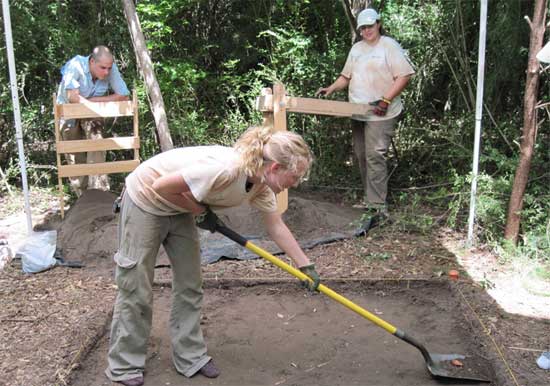 Archaeologists from the University of West Florida working in Molino have discovered what they believe may the first evidence of a Spanish mission settlement dating back to the 1750’s.
Archaeologists from the University of West Florida working in Molino have discovered what they believe may the first evidence of a Spanish mission settlement dating back to the 1750’s.
The Pensacola Colonial Frontiers Survey Field School, led by archaeologist John Worth, centers on the search for outlying communities associated with Pensacola’s three Spanish presidios including Native American villages and farmsteads. The students are searching an area along and near the Escambia River in Molino for a missions settlement that is believed to have included a Spanish missionary church and a small Apalachee Indian village.
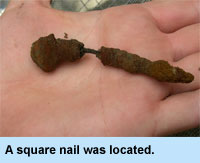 A wall trench was discovered last week, perhaps from the mission that archeologists are seeking. A square hand-wrought nail was located near the wall trench, suggesting European construction instead of Native American.
A wall trench was discovered last week, perhaps from the mission that archeologists are seeking. A square hand-wrought nail was located near the wall trench, suggesting European construction instead of Native American.
The wall area appears to have been a post-on-sill construction type that was commonly used on French colonial sites, but it has also been documented in Pensacola’s Spanish presidios. UWF archeologists said the Molino site also includes an apparent floor structure on the inside of the building.
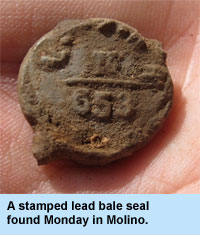 Monday, field school students found a stamped lead bale seal with the letter “K” and the number “653″. The seals were often used in the 18th century to seal bales or bundles of cloth or other trade goods. Researchers said such seals are not uncommon at sites associated with Native American trading. They hope with a little research to be able to associate the seal with particular merchant on manufacturer.
Monday, field school students found a stamped lead bale seal with the letter “K” and the number “653″. The seals were often used in the 18th century to seal bales or bundles of cloth or other trade goods. Researchers said such seals are not uncommon at sites associated with Native American trading. They hope with a little research to be able to associate the seal with particular merchant on manufacturer.
Additional Native American ceramic fragments have been located, and archeologists are hoping that they are further proof they have located the remains of Mission Escambe. A native-made candlestick, called Colono Ware, was also located. The candlesticks were made by Native Americans for trade with, or sale to, Europeans. That is consistent with the presence of a Franciscan missionary, UWF researchers said.
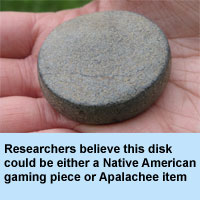 A well-made greenstone disk was found as well. Archeologists say the disk could either be a Native American gaming piece, or a Apalachee item from the mission period of interest. The greenstone probably originated about 100 miles away in Alabama.
A well-made greenstone disk was found as well. Archeologists say the disk could either be a Native American gaming piece, or a Apalachee item from the mission period of interest. The greenstone probably originated about 100 miles away in Alabama.
Last week, researchers found a “cob pit” — corn cobs allowed to burn and smolder in the pits to create smoke for mosquito control. The cob pits were very common in Spanish missions all across northern Florida. The corn cobs found in the Molino pit were from eight-row corn, the type of maize grown by American Indians during the period.
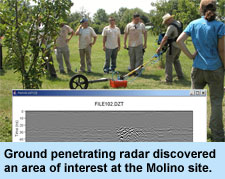 The latest digs were not “blind” — the UWF field school used ground penetrating radar to map the sub-surface in order to determine where to dig. A large area was found where the underground soil was different. Shovel tests in the area have turned up sheet metal and other modern artifacts — perhaps the location of a 20th century barn.
The latest digs were not “blind” — the UWF field school used ground penetrating radar to map the sub-surface in order to determine where to dig. A large area was found where the underground soil was different. Shovel tests in the area have turned up sheet metal and other modern artifacts — perhaps the location of a 20th century barn.
The Mission San Joseph De Escambe was established upriver along the Escambia River — which actually took its later name from the mission near Molino. The Apalachee Indian settlement with about 75 residents is well documented, according to archaeologist John Worth. It was established in the 1740’s. A Franciscan missionary was stationed by the Spanish at the village along with 15 members of a Spanish cavalry unit until about 1757.
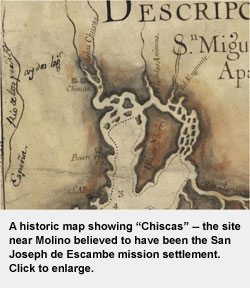 The village was led by Apalachee Chief Juan Marcos Fant until it was destroyed during a Creek Indian raid on April 9, 1761. The village and the church were at least partially burned during the raid. Following the raid, the residents moved down the Escambia River to what is now downtown Pensacola.
The village was led by Apalachee Chief Juan Marcos Fant until it was destroyed during a Creek Indian raid on April 9, 1761. The village and the church were at least partially burned during the raid. Following the raid, the residents moved down the Escambia River to what is now downtown Pensacola.
The Apalachee Indians created pottery for trade with the Spanish in Pensacola, and Worth would like nothing more than to find some of that pottery. If he’s lucky, Worth also hopes to find evidence that the Apalachee Indians also traded with the Upper Creek Indians of Alabama and directly, or indirectly with the French, even though the French and Indian War (1756-1763) was underway.
“Historical documents have narrowed our search for Pensacola’s lost Spanish missions, but now our students are conducting the archaeological fieldwork designed to locate them on the ground and learn more about this chapter of our local history,” said Worth.
There are about three weeks left in the UWF Archeology Field School in Molino. NorthEscambia.com will continue to follow the group’s progress and bring you updates over the coming weeks.
Editor’s Note: While we have mentioned that the archaeological dig is in the Molino area of North Escambia, we are not revealing the exact location at this point. It is all on private property (public access would be trespassing), and UWF wishes to protect the area until their work is done and to not compromise the integrity of any artifacts that might be in the area. Once the project is complete, we will publish an article with the exact location of the dig.
Pictured top: UWF Archeology Field School students open a two by two meter shovel test area Monday in Molino to further study a possible Spanish missionary wall trench located last week. Pictured below: A native-made candlestick, possibly for trade with Europeans. Submitted photos for NorthEscambia.com, click to enlarge.
Comments
8 Responses to “UWF Archeology Uncovers Possible Spanish Mission Evidence In Molino”



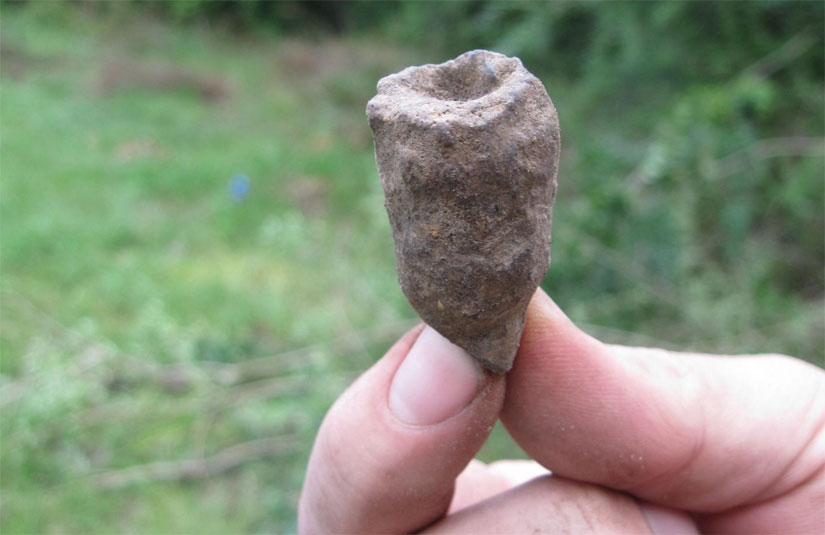
Hello from Spain
In the last picture looks a MOLINO
What kind of mill can be?
It could be a crucible for melting gold?
Thank you
Adriana Alzate Gallego
Antropologa. de Antioquia. Colombia
Doctoranda. U de Barcelona. España
At the moment I’m most interested in knowing the source for the name Fant attributed to the chief. Come on somebody, make my work easy for me. I have family members waiting.
REGARDING:
“This sentence indicates that the Indians would not be trading with the French because the war was underway. This would be historically incorrect. The French and Indian war was not a war where the 2 were against each other. The French and Indians were fighting and working together to stop the British from advancing to occupy more land south and west.”
True, but worth noting American Indians fought on both sides of the conflict.
Generally, though, the French got along better with the Indians than the British because they mainly wanted to trade, not colonize. In a trade, both sides benefit, in a colonization, somebody gotta move.
Also notewothy in the previous century that the British colonies who gained freedom often had little to do with the UK but the former French colonies mostly maintained good relations. In fact, the French often did the same jobs as before but as contract administrators.
smart folks, the French
Hooray for you guys! Keep at it. Love reading this.
—”If he’s lucky, Worth also hopes to find evidence that the Apalachee Indians also traded with the Upper Creek Indians of Alabama and directly, or indirectly with the French, even though the French and Indian War (1756-1763) was underway.”—
This sentence indicates that the Indians would not be trading with the French because the war was underway. This would be historically incorrect. The French and Indian war was not a war where the 2 were against each other. The French and Indians were fighting and working together to stop the British from advancing to occupy more land south and west. So they would have been trading and working together.
I agree. It’s wonderful to see some good in our end of the county. Thank you for printing this story, and please keep us updated on this dig site.
This was a refreshing story northescambia. We appreciate knowing about this and look forward to new updates soon. I hope they find the whole thing and we can open a big ole museum in Molino. Maybe we can get some of that maritime park money to build it.
Thanks. With everything else going on it is nice to see articles such as this to remind us of our history.